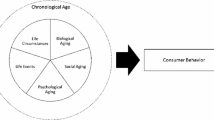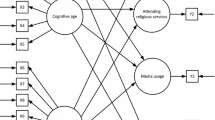Abstract
Older adults constitute a rapidly growing demographic segment, but stereotypes persist about their consumer behavior. The goal of this review was to develop a more considered understanding of age-associated changes in consumer decision making. Our theoretical model suggests that age-associated changes in cognition, affect, and goals interact to make older consumers’ decision-making processes, brand choices, and habits different from those of younger adults. We first review literature on stereotypes about the elderly and then turn to an analysis of age differences in the inputs (cognition, affect, and goals) and the outcomes (decisions, brand choices, and habits) of decision processes.
Similar content being viewed by others
References
Avnet, T., & Tory Higgins, E. (2006). How regulatory fit affects value in consumer choices and opinions. JMR, Journal of Marketing Research, 43, 1–10 (February). doi:10.1509/jmkr.43.1.1.
Cabeza, R. (2002). Hemispheric asymmetry reduction in older adults: The HAROLD model. Psychology and Aging, 17, 85–100. doi:10.1037/0882-7974.17.1.85.
Carstensen, L. L., Fung, H. H., & Charles, S. T. (2003). Socioemotional selectivity and the regulation of emotion in the second half of life. Motivation and Emotion, 27(2), 103–123. doi:10.1023/A:1024569803230.
Castel, A. D. (2005). Memory for grocery prices in younger and older adults: The role of schematic support. Psychology and Aging, 20, 718–721. doi:10.1037/0882-7974.20.4.718.
Chasseigne, G., & Mullet, E. (2007). Learning, inhibition, cognitive aging. Unpublished manuscript.
Cuddy, A. J. C., Norton, M. I., & Fiske, S. T. (2005). This old stereotype: The stubbornness and pervasiveness of the elderly stereotype. The Journal of Social Issues, 61, 267–285. doi:10.1111/j.1540-4560.2005.00405.x.
Drolet, A., & Suppes, P. (2007). The good and the bad, the true and the false. In M. C. Galavotti, R. Scazzieri, & P. Suppes (Eds.), Reasoning, rationality, and probability. Stanford, CA: CSLI Publications.
Drolet, A., Suppes, P., & Bodapati, A.V.(2007). Habits and free associations: Free your mind and mind your habits. Working paper.
Ebner, N. C., Freund, A. M., & Baltes, P. B. (2006). Developmental changes in personal goal orientation from young to late adulthood: from striving for gains to maintenance and prevention of losses. Psychology and Aging, 21(4), 664–678. doi:10.1037/0882-7974.21.4.664.
Fung, H. H., & Carstensen, L. L. (2003). Sending memorable messages to the old: Age differences in preferences and memory for advertisements. Journal of Personality and Social Psychology, 85(1), 163–178. doi:10.1037/0022-3514.85.1.163.
Glenn, N. (2005). Cohort analysis. Thousand Oaks, CA: Sage.
Gutchess, A. H., Kensinger, E. A., & Schacter, D. L. (2007). Aging, self-referencing, and medial prefrontal cortex. Social Neuroscience, 2, 117–133.
Gutchess, A. H., et al. (2005). Aging and the neural correlates of successful picture encoding: Frontal activations compensate for decreased medial-temporal activity. Journal of Cognitive Neuroscience, 17, 84–96. doi:10.1162/0898929052880048.
Heckhausen, J. (1997). Developmental regulation across adulthood: Primary and secondary control of age-related changes. Developmental Psychology, 33, 176–187. doi:10.1037/0012-1649.33.1.176.
Hess, T. M., et al. (2005). Aging-related selectivity and susceptibility to irrelevant affective information in the construction of attitudes. Aging, Neuropsychology, and Cognition, 12, 149–174. doi:10.1080/13825580590925170.
Labouvie-Vief, G. (1998). Cognitive-emotional integration in adulthood. Annual Review of Gerontology & Geriatrics, 17, 206–237.
Lambert-Pandraud, R., & Laurent, G. (2007). Tell me which perfume you wear, I’ll tell how old you are: Modeling the impact of consumer age on product choice. Working paper, HEC Paris.
Lambert-Pandraud, R., Laurent, G., & Lapersonne, E. (2005). Repeat purchasing of new automobiles by older consumers: Empirical evidence and interpretations. Journal of Marketing, 69, 97–113 (April). doi:10.1509/jmkg.69.2.97.60757.
Léoni, V., Mullet, E., & Chasseigne, G. (2002). Aging and intuitive physics. Acta Psychologica, 111, 29–43. doi:10.1016/S0001-6918(01)00077-4.
Meyer, B. J. F., Russo, C., & Talbot, A. (1995). Discourse comprehension and problem solving: Decisions about the treatment of breast cancer by women across the life span. Psychology and Aging, 10, 84–103. doi:10.1037/0882-7974.10.1.84.
Musielak, C., Chasseigne, G., & Mullet, E. (2006). The learning of non-linear functions among younger and older adults. Experimental Aging Research, 32, 317–340. doi:10.1080/03610730600699126.
Park, D. C., & Gutchess, A. H. (2004). Long-term memory and aging: a cognitive neuroscience perspective. In R. Cabeza, L. Nyberg, & D.C. Park (Eds.), Cognitive neuroscience of aging: Linking cognitive and cerebral aging. New York: Oxford Press.
Park, D. C., et al. (1994). Cognitive function and medication usage in older adults. Journal of Applied Gerontology, 13, 39–57. doi:10.1177/073346489401300104.
Pennington, G. L., & Roese, N. J. (2003). Regulatory focus and temporal distance. Journal of Experimental Social Psychology, 39, 563–576. doi:10.1016/S0022-1031(03)00058-1.
Peters, E., et al. (2007a). Adult age differences in dual information processes: Implications for the role of affective and deliberative processes in older adults’ decision making. Perspectives on Psychological Science, 2(1), 1–23.
Peters, E., et al. (2007b). Numeracy skill and the communication, comprehension, and use of risk and benefit information. Health Affairs, 26(3), 741–748. doi:10.1377/hlthaff.26.3.741.
Williams, P., & Drolet, A. (2005). Age-related differences in responses to emotional advertisements. The Journal of Consumer Research, 32, 343–354. doi:10.1086/497545.
Yoon, C., & Cole, C. A. (2008). Aging and consumer behavior. In Haugtvedt, Kardes, and Herr (Eds.), The Handbook of Consumer Psychology. New York: Lawrence Erlbaum Associates, pp 247–272.
Yoon, C., Gutchess, A., Feinberg, F., & Polk, T. A. (2006). Comparing the structures of brand and human personality: A functional magnetic resonance imaging study. The Journal of Consumer Research, 33, 31–40. doi:10.1086/504132.
Author information
Authors and Affiliations
Corresponding author
Rights and permissions
About this article
Cite this article
Cole, C., Laurent, G., Drolet, A. et al. Decision making and brand choice by older consumers. Mark Lett 19, 355–365 (2008). https://doi.org/10.1007/s11002-008-9058-x
Published:
Issue Date:
DOI: https://doi.org/10.1007/s11002-008-9058-x




